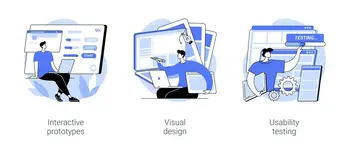
Table of contents
People like to interact with technology. They use social media and video games to connect with others and feel like they are in control.
A study by the
Pew Research Center
found that 85% of Americans own a smartphone, and 72% of those people use their phones to access social media. This means that people want to connect with others, even if it is through a screen. One of the reasons why people love interactivity is that it allows them to connect with others in a real way, even if it is through a digital platform.
Video games are also popular. The global gaming market is expected to reach
$218.7 billion by 2024
. Video games offer a unique form of interactivity. Players can immerse themselves in a virtual world and control their own destiny. This sense of control can be appealing, especially in a world where we often feel like we have no control.
What is Interactive Content

Interactive content refers to digital material that actively engages users and allows them to participate, make choices, and influence the content’s outcome. Unlike traditional static content that users simply consume, interactive content requires users to interact with elements on the screen, providing a dynamic and engaging experience
Interactive content can take various forms, from quizzes, polls, and surveys to videos with clickable hotspots, choose-your-own-adventure stories, and virtual reality experiences. The key characteristic of interactive content is that it responds to user actions, encouraging users to actively engage, explore, and make decisions.
This type of content is designed to capture and hold users’ attention by offering a sense of agency and personalization. Through their interactions, users can shape their experience, explore different pathways, and often receive immediate feedback based on their choices. This not only makes the content more engaging but also enhances learning, entertainment, and information retention.
Interactive content is widely used in digital marketing, education, entertainment, and various other fields to create memorable and immersive experiences that resonate with users. It leverages technology to bridge the gap between content creators and consumers, fostering a deeper level of engagement and interaction.
The Science Behind Interactivity
Interactivity is a feature that allows people to interact with digital content. It has become very popular in the digital age and is a key element in many popular websites, apps, and games. People love interactivity because it makes them feel like they are more involved in the content. It also makes the content more engaging and fun to use.
For example, a website with interactivity might allow users to click on different buttons or images to learn more about a topic. An app with interactivity might let users play games or solve puzzles. And a game with interactivity might let players choose their own path through the story.
Interactivity is appealing because it gives people a sense of control. It also makes the content more personal and relevant to the user. This can lead to a better user experience and increased engagement.
(a) The Brain’s Response to Interactivity

The brain likes interactivity. When we use interactive content, our brains make happy chemicals called dopamine. This is why interactive content can be so fun. It makes our brains feel good.
Studies have shown that people remember things better if they learn them through interactive experiences. This is because interactive content uses many parts of the brain, like the visual cortex, the auditory cortex, and the motor cortex. When we use interactive content, we are more likely to remember what
(b) The Role of Dopamine in Interactivity
Dopamine is a chemical in the brain that makes us feel good. When we interact with something, like a video game or a social media app, our brains release dopamine. This makes us want to keep interacting with that thing, because it feels good.
This is why interactive content can be so addictive. It releases dopamine in the brain, just like drugs and gambling. And the more we interact with it, the more dopamine our brains release, and the more addicted we become.
Research has shown that dopamine levels increase even more in response to interactive content than they do in response to non-interactive content. This suggests that interactivity is a key factor in how our brains respond to digital content.
In other words, the more we have to do in order to get something, the more our brains will reward us for doing it. This is why video games and social media apps can be so addictive. They keep us engaged by giving us new things to do all the time.
So next time you’re feeling tempted to spend hours on your phone or playing video games, remember that your brain is being tricked into thinking that it’s getting a reward. And if you’re not careful, you could become addicted.
Examples of Interactive Content
There are many different kinds of interactive content examples including; interactive infographics, games, quizzes, interactive videos, interactive maps, and simulations. One example of a very interactive website is the
New York Times article 'Snow Fall'
." It uses text, pictures, and videos to create a story that you can feel like you are inside of.
Another example of an interactive experience is the video game “
Fortnite
.” It is very interactive because you can build things, explore the world, and fight other players.
In conclusion, interactivity is a very important part of many successful websites, apps, and games. Our brains are wired to like interactivity, and when we engage with interactive content, our brains release a chemical called dopamine, which makes us feel good. This is why interactive content can be so addictive. By understanding the science behind interactivity, we can create more engaging and effective digital content.
The Appeal of Interactivity in Entertainment

People like interactivity in entertainment because it lets them participate in the story. They can make choices that affect the outcome, and they feel like they are part of the action. In this section, we will learn more about why interactivity is so appealing, and how it has become an important part of the entertainment industry.
1. Video Games: The Ultimate Interactive Experience
Video games are very fun because you can control the character and make decisions that change the game. This is why so many people play video games, even adults. A study found that
65% of American adults
play video games, and the average age of a gamer is 35. This shows that video games are popular with people of all ages.
Video games are more immersive than other forms of entertainment because you feel like you are the character. The decisions you make affect what happens in the game, so you feel like you are in control of the story. This is why video games are so addictive. You want to keep playing to see what happens next.
The ability to interact with the game world and control the outcome of the story is what makes video games so popular. They are more than just a way to pass the time. They are a way to escape into another world and be someone else for a while.
2. Interactive Movies: The Future of Cinema?
Interactive movies are a new type of movie that lets you make choices that change the story. This is different from regular movies, where you just watch the story happen.
Interactive movies can appeal to a wider audience because they offer a different experience. A study by
Deloitte
found that 67% of millennials and 75% of Gen Z are interested in interactive movies.
Interactive movies are more engaging than regular movies because you get to make choices. This makes you feel like you are part of the story and makes it more exciting.
Interactivity is becoming more important in entertainment. Video games and interactive movies are more engaging than regular movies or TV shows. As technology gets better, we will see more interactive entertainment in the future.
The Impact of Interactivity on Social Media

Social media is a big part of our lives now, and interactivity is one of the reasons why it’s so popular. Interactivity means that people can interact with the content and with each other in real-time. This section will talk about how interactivity affects social media, including how it makes people feel when they get likes and comments, and how it’s changing the way we tell stories.
i. The Psychology of Likes and Comments
Likes and comments are two ways people can interact with social media posts. They let people share their thoughts and feelings about the post. A study by
Pew Research Center
found that 72% of adults in the United States use social media, and 73% of those users interact with social media every day. This shows that social media is important to people, and interactivity is a big part of that.
People like and comment on posts because they want social validation. They want to feel good about themselves and likes and comments give them that feeling. The more likes and comments a post gets, the more people see it, which can lead to more interaction. This creates a cycle that encourages people to keep posting and interacting with content.
ii. The Rise of Interactive Storytelling on Social Media
Interactive storytelling is a new way to tell stories on social media. It lets people interact with the story in a more fun and interesting way. Interactive stories often have polls, quizzes, and games in them.
A
report
says that interactive stories are getting more popular on social media. Instagram Stories has over 500 million people who use it every day, and it has added polls and quizzes to its stories. This shows that people want more interactive experiences on social media, and platforms are adding more interactive features to their sites.
In conclusion, interactivity has had a big impact on social media. It has made social media more engaging and fun. People like getting likes and comments on their posts, and interactive storytelling gives them a more fun and engaging way to get social validation. As social media continues to evolve, interactivity will probably keep being important to these platforms.
Interactivity in Education and Learning

Interactivity has been a buzzword in education for quite some time now. The concept of interactive learning has gained immense popularity in recent years and for good reason. Interactive learning is a teaching method that encourages students to actively participate in the learning process. It involves a two-way communication between the teacher and the students and between the students themselves. In this section, we will discuss the benefits of interactive learning and the future of education in interactive classrooms.
The Benefits of Interactive Learning
Interactive learning has been shown to have several benefits over traditional teaching methods. Here are a few of them:
1. Improved Retention
Studies have shown that students who actively participate in the learning process retain more information than those who do not. Interactive learning encourages students to engage with the material, which helps them retain it better.
2. Increased Engagement
Interactive learning is more engaging than traditional teaching methods. It encourages students to ask questions, participate in discussions, and collaborate with their peers. This makes the learning process more enjoyable and helps students stay focused.
3. Better Problem-Solving Skills
Interactive learning helps students develop critical thinking and problem-solving skills. By engaging with the material and discussing it with their peers, students learn to analyze and evaluate information, which helps them develop these skills.
4. Improved Communication Skills
Interactive learning also helps students develop better communication skills. By participating in discussions and collaborating with their peers, students learn to express their ideas clearly and effectively.
The Future of Education: Interactive Classrooms

The future of education lies in interactive classrooms. With the advancement of technology, interactive learning has become more accessible than ever before. Interactive classrooms use technology to enhance the learning experience and encourage active participation from students.
Interactive classrooms can take many forms, from online learning platforms to virtual reality classrooms. These technologies allow students to engage with the material in new and exciting ways, making the learning process more enjoyable and effective.
According to a report by GlobeNewswire, the Global Interactive Whiteboard Market Size To Worth USD 8.16 Billion By 2032. This shows that there is a growing demand for interactive learning technologies in education.
In conclusion, interactive learning has several benefits over traditional teaching methods. It improves retention, increases engagement, develops problem-solving and communication skills, and is the future of education. With the growing demand for interactive learning technologies, we can expect to see more interactive classrooms in the years to come.
The Dark Side of Interactivity
While interactivity can be a great tool for engagement and learning, there are some potential downsides to consider. In this section, we will explore some of the dangers of overstimulation and addiction to interactivity.
(a) The Dangers of Overstimulation
When individuals are exposed to too much interactivity, it can lead to overstimulation. This can cause a range of negative effects, including anxiety, stress, and fatigue. Overstimulation can also lead to decreased attention span and reduced ability to focus, which can be detrimental to learning and productivity.
In a study published in the Journal of Computer-Mediated Communication, it was found that the more interactive a website was, the more likely users were to experience cognitive overload. This overload can lead to decreased satisfaction with the website and decreased likelihood of returning to it in the future.
(b) The Addiction to Interactivity
Interactivity can also be addictive. When individuals experience the sense of control and engagement that comes with interactivity, it can trigger a release of dopamine in the brain. This can create a desire for more interactivity, leading to addiction.
In a study published by the National Institute of Health, it was found that excessive internet use, including excessive use of interactive websites and social media, was associated with increased rates of depression, anxiety, and stress. This suggests that addiction to interactivity can have serious negative consequences.
To avoid these negative effects, it is important to use interactivity in moderation and to take breaks when necessary. It is also important to be aware of the potential for addiction and to seek help if necessary.
Overall, while interactivity can be a great tool for engagement and learning, it is important to be aware of the potential dangers and to use it responsibly.











